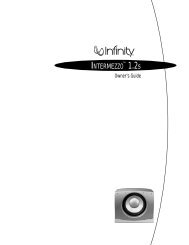Leica Sport Optics - One Call
Leica Sport Optics - One Call
Leica Sport Optics - One Call
Create successful ePaper yourself
Turn your PDF publications into a flip-book with our unique Google optimized e-Paper software.
Glossary For illustration purposes, the pictorial examples show strongly exaggerated<br />
effects of the various types of imaging errors or aberrations.<br />
Optical quality Imaging errors (aberrations) In order for a sharp image to be created, light from a point on the subject must re-converge as a<br />
point in the picture. As a rule, a single lens element is not adequate for this purpose, because it has inherent deviations (imaging<br />
errors or aberrations), that are described a follows : By selecting appropriate types of optical glass and lens coatings, and by<br />
combining the right lens elements and by converting the computed lens design into reality a accurately as possible, <strong>Leica</strong> succeeds<br />
in keeping all the residual aberrations at a very low level. To that end all phases, from optical design to fabrication, are<br />
optimized for the always highest possible imaging quality.<br />
Contrast and resolving power Contrast is defined as the difference in brightness between light and dark areas of the image. The<br />
greater this difference, the higher the contrast. An image that is rich with contrast is subjectively perceived to be sharper and more<br />
brilliant. Resolving power is the extent to which an optical system is capable of reproducing the finest structures. The greater the<br />
resolving power, the better are the finest details rendered, even under difficult light conditions. Pictorial examples : In optimally<br />
rendered images (left), both contrast and resolution are high. If the contrast is too low, the image is flat (center). If the resolution<br />
is too low, the image is unsharp, one can no longer discern details in the feathers (right).<br />
Reflections and flare When light rays are reflected by lens surfaces and/or structural<br />
components or scattered by lens mounts, they arrive at a location in the image that is<br />
different from the one where they are intended to arrive. Undesired reflections and light<br />
areas that can degrade the image significantly and that can impair the visual impression<br />
occur especially when the sun shines directly into the front lens. To prevent reflections<br />
and flare caused by stray light rays, <strong>Leica</strong> takes numerous dedicated steps. To begin with,<br />
the shapes of lens surfaces, mounting components and light traps are already optimized<br />
during the design stage so that no extremely disturbing effects are to be expected.<br />
Furthermore, a significant reduction in reflections and stray light components is achieved<br />
by means of special coatings of lens elements (vapor deposition of special reflectionreducing<br />
layers) and by the matte black finish of internal mechanical components.<br />
Depth of field Depth of field is the distance between the nearest and the furthest away<br />
objects that can still be perceived as being sharp at a given focus setting without the need for<br />
refocusing. The depth of field is dependent upon the magnification of a binocular or spotting<br />
scope. The lower the magnification, the greater the depth of field. Therefore, if one wishes to<br />
see several objects at different distances but with the same sharpness (as illustrated on the<br />
left), one would give preference to a binocular with a 7 x or 8 x magnification, which would<br />
also have great advantages for observation at twilight or in poor light conditions, because<br />
one would not have keep refocusing to maintain a sharp image. The greater the magnification,<br />
the smaller the depth of field. Greater magnifications are advantageous when one wishes<br />
to discern more details or smaller objects, as illustrated on the right.<br />
Aperture errors – spherical aberration The closer to the edge light rays pass<br />
through a lens, the more they will tend to arrive away from the actual picture<br />
point. Because this effect becomes stronger as the front lens diameter increases,<br />
it is referred to as aperture error, also called spherical aberration. Aperture<br />
error causes a loss of sharpness and contrast in the image. In extreme cases,<br />
flare becomes noticeable – halos are formed around point sources of light, as<br />
illustrated in the pictorial example above.<br />
Coma When coma is present, light rays will deviate to one side of their intended<br />
picture point. The picture point will gain a tail like a comet. This effect occurs<br />
more towards the edges of the picture and not in its center. Strong coma leads<br />
to a loss in sharpness and contrast, in extreme cases the coma tail becomes<br />
noticeable in point sources of light, as illustrated in the enlarged section of a<br />
picture of a star. This section was cropped from the left upper corner of the<br />
moon picture.<br />
88 / 89

















